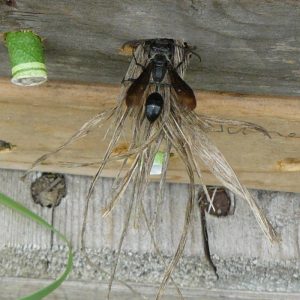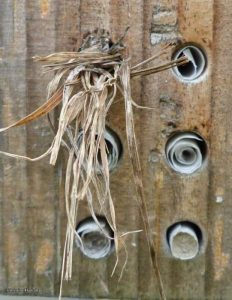by Sandy Garland

Grass-carrying wasps (Isodontia mexicana) use hollow stems or tunnels in wood to build nests for their offspring
I love this species because it’s so easy to identify, especially if it’s building a nest. I was watching the insect hotel at the Fletcher Wildlife Garden one day and noticed that several “rooms” were stuffed with bundles of grass.
“Who would do that?” I exclaimed and bent down for a closer look thinking that vandals had plugged up potential nest holes. I was about to pull out the grass stems when a wasp flew over my shoulder and proceeded to poke another blade of grass into the hole.
I was astonished. I hurried home and Googled “wasp carrying grass.” More astonishment – and some laughter – when the search engine came up with “Grass-carrying Wasp (Isodontia mexicana).”
We are trying to find out as much as we can about all our local pollinators, and, as this one is now dear to my heart, I Googled its name recently and found a wonderful article by Heather Holm, containing just about everything I wanted to know about this creature: Meet the Grass-Carrying Wasp, a Gentle Pollinator of Summer Flowers.
I learned that it IS a pollinator. Even though it gathers dead insects, not pollen, for its offspring, the adults visit flowers to feed on nectar and, in doing so, incidentally carry pollen from one plant to the next. And I learned that the cocoons I have in my refrigerator are likely a second generation of larvae and they will emerge in early summer – lots of time for me to get them back outside where they’ll find the resources they’ll need as adults.
Heather’s article mentions the kinds of wildflowers these wasps prefer, what sorts of nesting sites they use, and other interesting facts about the various stages of their life cycle. I enjoyed seeing the many photos she included, especially the ones showing the inside of a nest tunnel. At the FWG, we have not observed them using plant stems or the rolled paper tunnels we make for Mason Bees. But we do see them using holes in wood quite regularly. (Note: we line these holes with parchment, which can be replaced, making them easy to clean.)
Please let us know if you see these wasps in your backyard. By all accounts, they are NOT aggressive, so welcome them as another member of our local pollinator “team.”
One more thing: Grass-carrying wasps will nest in any small hole, so people often find bundles of grass wedged into spaces around window frames. This is NOT a reason for concern and the wasps know what they are doing, so please be content to share the space until the adults emerge in early summer.
Other articles on the Grass-carrying Wasp
- Window wasps: the Grass-carrying Wasps, Isodontia spp. (Bug of the week blog)
- Video showing nest-building in a drain hole (U Nebraska, Lincoln)
- The grass-carrying wasp: A solitary wasp that builds nests in unusual places (Michigan State U)
- Grass-carrying Wasps (BugGuide)
